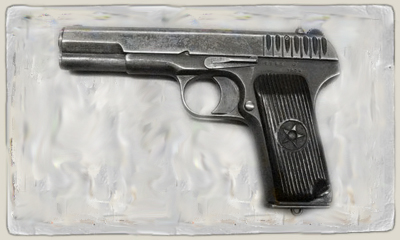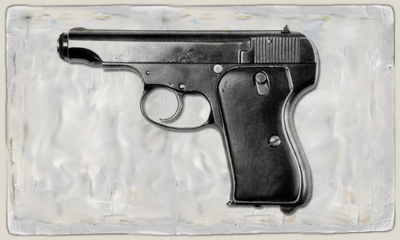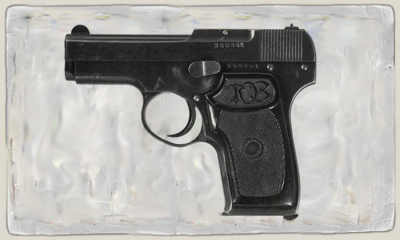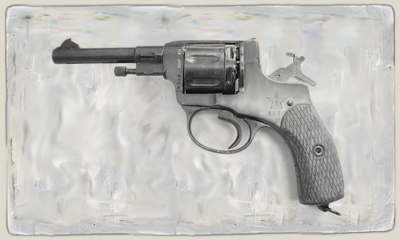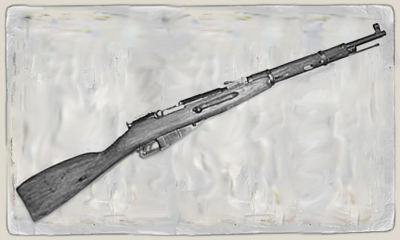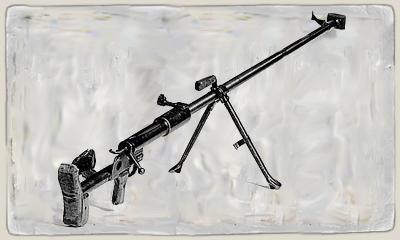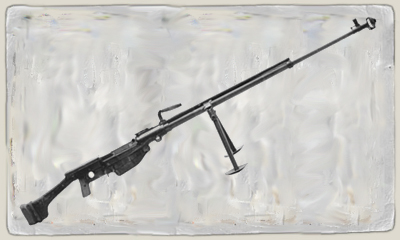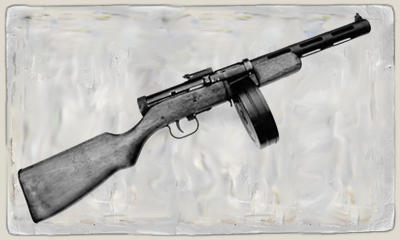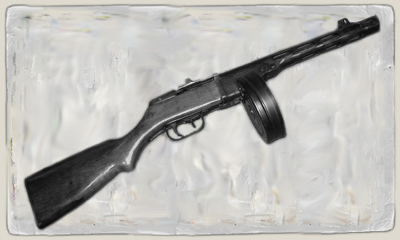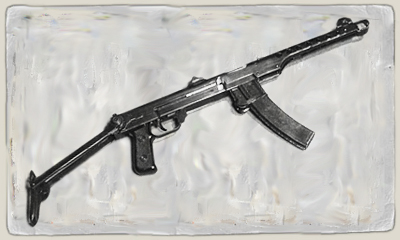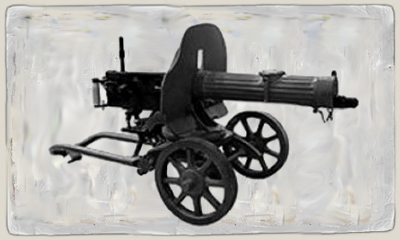PistolsTT Pistol
The TT-30 (7,62 mm Samozarjadnyj Pistolet Tokareva obrazca 1930 goda) is a semi-automatic pistol developed by Fedor Tokarev as a service pistol for the Soviet military to replace the Nagant M1895 revolvers in use since tsarist times. In 1930, the Revolutionary Military council approved a resolution to test new small arms to replace its aging Nagant M1895 revolvers[1]. During these test, on January 7, 1931, the potential of a pistol designed by Fedor Tokarev was noted. A few weeks later, 1000 TT-30's were ordered for troop trials, and the pistol was adopted for service in the Red Army. During these test, on January 7, 1931, the potential of a pistol designed by Fedor Tokarev was noted. A few weeks later, 1000 TT-30's were ordered for troop trials, and the pistol was adopted for service in the Red Army. But even as the TT-30 was being put into production, design changes were made to simplify manufacturing. Minor changes to the barrel, disconnector, trigger and frame were implemented, the most notable ones being the omission of the removable back strap and changes to the full-circumference locking lugs. This redesigned pistol was the TT-33. The TT-33 was widely used by Soviet troops during World War II, but did not completely replace the Nagant until that war, but did not completely replace the Nagant until that war. Externally, the TT-33 is very similar to John Browning's blowback operated FN Model 1903 automatic pistol, but it also used Browning's short recoil dropping-barrel system from the 1911 series. The TT-33 is not a 1911 clone, however, as it employs a much simpler hammer/sear assembly with an external hammer. This assembly is removable from the weapon as a modular unit and includes cartridge guides that provide reliable functioning. The Soviet engineers also added several other features such as locking lugs all around the barrel (not just on top), and made several alterations to make the mechanism easier to produce and maintain. Production even machined the magazine feed lips into the receiver to prevent damage and misfeeds when a distorted magazine was loaded into the magazine well. The TT-33 is chambered for the 7.62x25mm Tokarev cartridge, which was itself based on the similar 7.63x25mm Mauser cartridge used in the Mauser C96 pistol. Able to withstand tremendous abuse, large numbers of the TT-33 were produced during WWII and well into the 1950s. cartridge used in the pistol. Able to withstand tremendous abuse, large numbers of the TT-33 were produced during WWII and well into the 1950s.
Voevodin pistol
Voevodin pistol was somehow bigger and heavier than TT-pistol, but it compared favourably according all its characteristics, - professor D. N. Bolotin wrote.- It was equal to such foreign pistols as Parabellum, Webley-Scott, Mauser-Astra in accuracy of fire, and in rate of fire and muzzle velocity it had no parallels.” In 1938 the works on the more perfect model finished. It was made by Tokarev, Rakov, Korovin, and Voevodin. Pistol tests were finished only in April, 1941. There was manufactured only a small batch which was distributed among the leaders of Red Army.
TK pistol (Pistolet Korovina)
TK pistol was the first Soviet model of self-loading pistol. It was designed by Sergey Aleksandrovich Korovin in 1920-1921 as a sports pistol but was very popular among the commanders of Red Army. In some museums one can see TK pistols which had been given to best workers and stakhanovites. There were manufactured about 300 000 pistols. Pistol automatic works owing to the recoil of free slide. Trigger and firing mechanism. Unregulated sight. Non automatic safety fuse flag is on the left side, under the guard plate. Pistol stock is made of wood.
Mauser C96
The C96 is a semi-automatic pistol that was manufactured from 1896 to 1936 in Germany. It was one of the first semi-automatic pistols to see widespread use. It was also manufactured in direct or modified form in Spain and China in the first half of the 20th Century. The main characteristics that distinguish the C96 are the integral box magazine in front of the trigger, the long barrel, the wooden shoulder stock which can double as a holster or carrying case, and a grip shaped like the end of a broom's handle (which earned it the nickname "Broomhandle" in the English-speaking world). The Mauser C96 can be considered one of the first personal defense weapons (PDWs), as its long barrel and powerful cartridge gave it superior range and better penetration capabilities than most other standard pistols.), as its long barrel and powerful cartridge gave it superior range and better penetration capabilities than most other standard pistols. There were many variants of the C96, notably the so-called "Bolo" version with a shorter barrel and smaller grips (which was manufactured after German handgun manufacturers were required to conform to Versailles restrictions on pistol barrel length). The Bolo earned that name due to the fact that the Bolshevik government of the Soviet Union in 1920s placed large orders for that model. There were versions with detachable magazines varying in size from 6 to 40 rounds (instead of the integral magazine seen on most pre-1930s versions), and models such as the M712 Schnellfeuer ("rapid fire") machine pistol from 1932 that was capable of fully automatic fire. All versions were made to use detachable shoulder stocks that doubled as holsters. A small number of carbine models with wooden stocks, wooden fore grips and much longer barrels were also manufactured. During World War I the Imperial German Army contracted with Mauser for 150,000 C96 pistols chambered for the 9 mm Parabellum. This variant was named the "Red 9" after a large number "9" burned and painted in red into the grip panels, to prevent the pistols' users from loading them with 7.63 mm ammunition by mistake. Of the 150,000 pistols commissioned, approximately 135,000 were delivered before the war ended. This was the only time in which the C96 was ever used officially by the German army. The C96 was originally designed for the 7.63x25mm Mauser cartridge, but many were also made in 9x19mm Parabellum and 9 mm Mauser Export, a much more powerful cartridge than the 9 mm Parabellum. Versions in .45 ACP caliber were produced by China in the Shansi province. The C96 was also manufactured on a limited or experimental basis in 7.65x25mm Borchardt, 9 mm Mauser, 7.65x22mm Parabellum, 8.15mm Mauser, and 9 mm Largo (Bergmann).
Nagant M1895
The Nagant Revolver was designed and produced by a Belgian industrialist, Léon Nagant. It was adopted, in various forms, by the police and military services of Sweden (as M1887 in 7.5 mm caliber), Norway (as M1893), Poland, France (in 8 mm) and Greece (as Peristrofon M1895), among others. The most famous user though was Russia, who adopted it as the model of 1895. Léon Nagant and his brother Emile were well known in the Russian Tsar's court and military administration because of the important part they had played in the design of the Russian service rifle, the Mosin-Nagant model of 1891. The Nagant M1895 became the standard issue side arm for Russian army and police officers, later including the special services, the NKVD and the KGB. Production began in Liège, Belgium, but was soon moved to Russia. The revolver began to be replaced by a more modern, semi-automatic pistol, the Tokarev, in 1933, but it was still produced and used in great numbers during the Great Patriotic War. Its distinctive shape and name helped it achieve cult status in Russia, and in the early 1930s the presentation of a Nagant M1895 revolver with an embossed Red Star was one of the greatest honours that could be bestowed on a Party Member. Production and usage continued until 1950, making it one of the longest-serving side arms in modern military history, but not longer than the Webley Service Revolver (1887-1963) and the Colt M1911 (1911-1984). It is still in use with the Russian Railways and various remote police forces. Most other (non-gas seal) revolvers have a small gap between the cylinder and the barrel; the small gap between the cylinder and barrel is necessary to allow the revolver's cylinder to revolve, presenting a new, loaded chamber for firing. This necessitates that the bullet jump the gap when fired, which may have an adverse effect on accuracy, especially if the barrel and chamber are misaligned, and also presents a path for the escape of high-pressure and high-temperature gases from behind the bullet. The M1895 has a mechanism which, as the hammer is cocked, first turns the cylinder and then moves it forward, closing the gap between the cylinder and the barrel. The cartridge, also unique, plays an important part in sealing the gun to the escape of propellant gases. The bullet is deeply seated, entirely within the cartridge case, and the case is slightly reduced in diameter at its mouth. The barrel features a short conical section at its rear; this accepts the mouth of the cartridge, completing the gas seal. By sealing the gap, the velocity of the bullet is increased by 50 to 150 ft/s (15 to 45 m/s). This closed firing system meant that the Nagant revolver, unlike other revolvers, could be effectively fitted with a suppressor, as indeed it was [1]. During World War II, a small number of Nagant revolvers used by Russian recon and scout troops were outfitted with a variety of sound suppressor known as the “Bramit device.” The Cheka/NKVD/KGB were known to use the silenced Nagant for assassinations. Silenced Nagant revolvers, modified in clandestine metal shops, also turned up in the hands of Viet Cong guerrillas during the Vietnam War as assassination weapons. There is an example of a silenced Nagant M1895 in the CIA Museum in Langley, Virginia. However, success had its price. Nagant revolvers had to be reloaded one cartridge at a time through a loading gate with the need to manually eject each of the used cartridges. Therefore, reloading was laborious and time-consuming. However, the loaded revolver was safer to carry around and could stay loaded for longer periods of time. This was a major factor in the longevity of the weapon: such features made the weapon a good choice for those who had to carry the gun a lot, but did not need to fire it often, like officers or policemen. This, the ability to use a silencer, and the large number of "free" Nagant revolvers available from Russian army reserves put the weapon on the short list of options whenever a self-defense gun was needed. The Nagant M1895 was made in both single-action and double-action models before and during World War I; they are known colloquially as the “Private model” and the “Officer’s model”, respectively. Production of the single-action model seems to have stopped after 1918, with some exceptions, including examples made for target competition. Most single-action revolvers were later converted to double-action, making original single-action revolvers rather rare. The Nagant M1895 fires a unique cartridge, 7.62 mm Nagant, also known as 7.62x38mmR (Rimmed) or "Cartridge, Type R." The projectile is seated below the mouth of the cartridge, with the cartridge crimp sitting just above the bullet. When fired in the Nagant revolver, the crimp expands into the forcing cone, completing the gas seal and ostensibly increasing muzzle velocity by approximately 75 ft/s. The 7.62 mm calibre was chosen, in part, to simplify the tooling used in barrel-making and manufacture of projectiles—the Russian service rifle of the time—the Mosin Nagant M91 featured an identical bore diameter, being chambered for the 7.62x54R rifle cartridge. rifle cartridge. rifle cartridge. featured an identical bore diameter, being chambered for the rifle cartridge.
The PPD
(Pistolet-Pulemyot Degtyaryova) is a submachine gun originally designed in 1934 by Vasily Degtyaryov. It was a near direct copy of the German Bergmann MP28, and utilized a large ammunition drum, a copy of the Finnish M31 Suomi drum magazine, as well as a more conventional box-type magazine. It first went into military service in 1935 as the PPD-34. In 1938 and 1940, modifications were designated PPD-34/38 and PPD-40 respectively, and introduced minor changes. Nevertheless, the PPD-40 was too complicated and expensive to mass-produce, and although it was used in action in the initial stages of World War II, it was, by the end of 1941, quickly phased out and replaced by the superior and cheaper PPSh-41.
PPSh-41
The PPSh-41 (Pistolet-Pulemyot Shpagina); Shpagin Machine Pistol. The submachine gun was one of the most mass produced weapons of its type of World War II. It was designed by Georgy Shpagin, as an inexpensive alternative to the PPD-40, which was expensive and time consuming to build. The PPSh had a simple blow-back action, a box or drum magazine, and used the 7.62x25mm pistol round. It was made with metal stampings to ease production, and its chrome-lined chamber and bore helped to make the gun very low-maintenance in combat settings. The impetus for the development of the PPSh came partly from the Winter War against Finland, where it was found that submachine guns were a highly effective tool for close-quarter fighting in forests or built-up urban areas. The weapon was developed in mid-1941 and was produced in a network of factories in Moscow. A few hundred weapons were produced in November 1941 and another 155,000 were produced over the next five months. By spring 1942, the PPSh factories were producing roughly 3,000 units a day. The PPSh-41 was classic example of a design adapted for mass production. Its parts (excluding the barrel) could be produced by a relatively unskilled workforce with simple equipment available in an auto repair garage or tin shop, freeing up more skilled workers to other tasks. The PPSh-41 used 87 components compared to 95 for the PPD-40 and the PPSh could be manufactured with 7.3 machining hours compared with 13.7 hours for the PPD. Over 6 million of these weapons were produced by the end of the war. The Soviets would often equip whole regiments and even entire divisions with the weapon.
PPS
The PPS is a family of Soviet 7.62 mm submachine guns, designed in two main variants - the PPS-42 and PPS-43 by A. I. Sudaev as a personal defense weapon for reconnaissance units, vehicle crews and service personnel. , designed in two main variants - the and by as a personal defense weapon for reconnaissance units, vehicle crews and service personnel. Manufacturing of PPS began in blockade Leningrad in 1943. The PPS-42 is an automatic blowback-operated firearm, and is fired from an open bolt. It is chambered in the 7.62x25mm Tokarev M1930 pistol cartridge. The PPS features a striker firing mechanism (, trigger assembly and an external, lever-type safety that prevents accidental firing. The bolt also contains a spring-loaded extractor, which pulls the empty case out of the chamber and passes it to the fixed ejector. The weapon is fed from an arch-shaped 35-round box magazine that is not interchangeable with box magazines used with the PPSh-41 and the gun will not accept a drum magazine. The submachine gun's rifled barrel (has right-hand 4 grooves) is mounted in a perforated heat shield and has a muzzle brake, which also serves as a compensator reducing muzzle rise during rapid fire. The PPS is also equipped with: open-type iron sights, a folding metal stock that folds up and over the receiver frame and a pistol grip. Supplied with the PPS are: two magazine pouches, an oil bottle, bore brush and sling.
Maxim gun
The Maxim gun was the first self-powered machine gun, invented by the American-born Briton Sir Hiram Maxim in 1884.Maxim's first patents related to the development of the Maxim were registered in June and July 1883. The first prototype was demonstrated to invited guests in October 1884. The mechanism of the Maxim gun used the energy from the recoil force to eject each spent cartridge and insert the next one. This made it vastly more efficient and less manpower-demanding than previous machine guns. Trials showed that the Maxim could fire 600 rounds per minute, equivalent to the firepower of about 30 contemporary breech-loading bolt-action rifles. Compared to modern machine guns, the Maxim was heavy, bulky and awkward. Even though one person could fire the gun, it was usually operated by a team of men. The cooling mechanism of the weapon needed a constant supply of water in order to produce a continuous stream of fire, and several men were needed to move or shift its position. Maxim first established the Maxim Gun Company, mainly financed by Albert Vickers, son of steel entrepreneur Edward Vickers. Maxim gun was a heavy machine gun used by the Russian Army during World War I and the Red Army during World War II. It was adopted in 1910 and was a variant of Hiram Maxim's Maxim gun, chambered for the standard Russian 7.62x54mmR ammunition. The M1910 was mounted on a cumbersome wheeled mount with a gun shield and was replaced in Soviet service by the SG-43 Gorunov, starting in 1943. In addition to the main infantry version, there were aircraft mounted PV-1 and naval versions.
Degtyaryov machine gun
The Ruchnoy Pulemyot Degtyaryova Pekhotny (Degtyaryov hand-held infantry machine gun) The original DP is more commonly called the DP-28 (or DP-27), although there is some confusion as to whether these are official designations or not. DP was a light machine gun used by the Soviet Union starting in 1928. It fired the 7.62x54mmR cartridge and was cheap and easy to manufacture - early models had fewer than 80 parts and could be built by unskilled labour. The DP was especially able to withstand dirt. In tests it was buried in sand and mud and was still capable of firing more than 500 rounds. The DP's main drawback was its bipod; this part could not withstand much abuse and broke easily. Also, the magazine, which was usually a pan with 47 rounds that fed in from the top, was relatively small and continuous fire for long periods could not be relied on as much as contemporary belt fed weapons. It took some time to load a new magazine onto the weapon, and each magazine took a much longer time to load with ammunition. However, the DP's lower cyclic rate of fire meant a reduced risk of the barrel overheating. The DP machine gun was supplemented in the 1950s by the more modern but problematic RPD machine gun and entirely replaced in Soviet service by the general purpose PK machine gun in the 1960s.
SG-43 Goryunov
The SG-43 Goryunov was a Soviet medium machine gun that was introduced during the Second World War and is chambered for the 7.62x54mmR cartridge. It was introduced in 1943 as replacement for the older M1910 Maxim machine guns and was mounted on wheeled mounts, tripods and vehicles. After the end of World War II the SG-43 was improved and renamed SGM ("M" for modernized). A tank mounted variant was also developed under the designation SGMT. The SG-43/SGM was widely exported and also manufactured in China and elsewhere. Beside World War II it saw service in the Korean War by North Korean and Chinese forces; and in the Vietnam War it was used extensively by the North Vietnamese armed forces and NLF guerillas. In Soviet service, it was replaced in the 1960s by the PK. |
|||||||||||||||||

